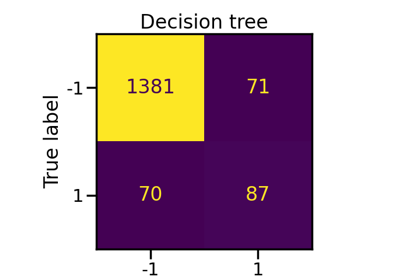BalancedRandomForestClassifier#
- class imblearn.ensemble.BalancedRandomForestClassifier(n_estimators=100, *, criterion='gini', max_depth=None, min_samples_split=2, min_samples_leaf=1, min_weight_fraction_leaf=0.0, max_features='sqrt', max_leaf_nodes=None, min_impurity_decrease=0.0, bootstrap=False, oob_score=False, sampling_strategy='all', replacement=True, n_jobs=None, random_state=None, verbose=0, warm_start=False, class_weight=None, ccp_alpha=0.0, max_samples=None, monotonic_cst=None)[source]#
A balanced random forest classifier.
A balanced random forest differs from a classical random forest by the fact that it will draw a bootstrap sample from the minority class and sample with replacement the same number of samples from the majority class.
Read more in the User Guide.
Added in version 0.4.
- Parameters:
- n_estimatorsint, default=100
The number of trees in the forest.
- criterion{“gini”, “entropy”}, default=”gini”
The function to measure the quality of a split. Supported criteria are “gini” for the Gini impurity and “entropy” for the information gain. Note: this parameter is tree-specific.
- max_depthint, default=None
The maximum depth of the tree. If None, then nodes are expanded until all leaves are pure or until all leaves contain less than min_samples_split samples.
- min_samples_splitint or float, default=2
The minimum number of samples required to split an internal node:
If int, then consider
min_samples_splitas the minimum number.If float, then
min_samples_splitis a percentage andceil(min_samples_split * n_samples)are the minimum number of samples for each split.
- min_samples_leafint or float, default=1
The minimum number of samples required to be at a leaf node:
If int, then consider
min_samples_leafas the minimum number.If float, then
min_samples_leafis a fraction andceil(min_samples_leaf * n_samples)are the minimum number of samples for each node.
- min_weight_fraction_leaffloat, default=0.0
The minimum weighted fraction of the sum total of weights (of all the input samples) required to be at a leaf node. Samples have equal weight when sample_weight is not provided.
- max_features{“auto”, “sqrt”, “log2”}, int, float, or None, default=”sqrt”
The number of features to consider when looking for the best split:
If int, then consider
max_featuresfeatures at each split.If float, then
max_featuresis a percentage andint(max_features * n_features)features are considered at each split.If “auto”, then
max_features=sqrt(n_features).If “sqrt”, then
max_features=sqrt(n_features)(same as “auto”).If “log2”, then
max_features=log2(n_features).If None, then
max_features=n_features.
Note: the search for a split does not stop until at least one valid partition of the node samples is found, even if it requires to effectively inspect more than
max_featuresfeatures.- max_leaf_nodesint, default=None
Grow trees with
max_leaf_nodesin best-first fashion. Best nodes are defined as relative reduction in impurity. If None then unlimited number of leaf nodes.- min_impurity_decreasefloat, default=0.0
A node will be split if this split induces a decrease of the impurity greater than or equal to this value. The weighted impurity decrease equation is the following:
N_t / N * (impurity - N_t_R / N_t * right_impurity - N_t_L / N_t * left_impurity)
where
Nis the total number of samples,N_tis the number of samples at the current node,N_t_Lis the number of samples in the left child, andN_t_Ris the number of samples in the right child.N,N_t,N_t_RandN_t_Lall refer to the weighted sum, ifsample_weightis passed.- bootstrapbool, default=True
Whether bootstrap samples are used when building trees.
Changed in version 0.13: The default of
bootstrapwill change fromTruetoFalsein version 0.13. Bootstrapping is already taken care by the internal sampler usingreplacement=True. This implementation follows the algorithm proposed in [1].- oob_scorebool, default=False
Whether to use out-of-bag samples to estimate the generalization accuracy.
- sampling_strategyfloat, str, dict, callable, default=”auto”
Sampling information to sample the data set.
When
float, it corresponds to the desired ratio of the number of samples in the minority class over the number of samples in the majority class after resampling. Therefore, the ratio is expressed as \(\alpha_{us} = N_{m} / N_{rM}\) where \(N_{m}\) is the number of samples in the minority class and \(N_{rM}\) is the number of samples in the majority class after resampling.Warning
floatis only available for binary classification. An error is raised for multi-class classification.When
str, specify the class targeted by the resampling. The number of samples in the different classes will be equalized. Possible choices are:'majority': resample only the majority class;'not minority': resample all classes but the minority class;'not majority': resample all classes but the majority class;'all': resample all classes;'auto': equivalent to'not minority'.When
dict, the keys correspond to the targeted classes. The values correspond to the desired number of samples for each targeted class.When callable, function taking
yand returns adict. The keys correspond to the targeted classes. The values correspond to the desired number of samples for each class.
Changed in version 0.11: The default of
sampling_strategywill change from"auto"to"all"in version 0.13. This forces to use a bootstrap of the minority class as proposed in [1].- replacementbool, default=False
Whether or not to sample randomly with replacement or not.
Changed in version 0.11: The default of
replacementwill change fromFalsetoTruein version 0.13. This forces to use a bootstrap of the minority class and draw with replacement as proposed in [1].- n_jobsint, default=None
Number of CPU cores used during the cross-validation loop.
Nonemeans 1 unless in ajoblib.parallel_backendcontext.-1means using all processors. See Glossary for more details.- random_stateint, RandomState instance, default=None
Control the randomization of the algorithm.
If int,
random_stateis the seed used by the random number generator;If
RandomStateinstance, random_state is the random number generator;If
None, the random number generator is theRandomStateinstance used bynp.random.
- verboseint, default=0
Controls the verbosity of the tree building process.
- warm_startbool, default=False
When set to
True, reuse the solution of the previous call to fit and add more estimators to the ensemble, otherwise, just fit a whole new forest.- class_weightdict, list of dicts, {“balanced”, “balanced_subsample”}, default=None
Weights associated with classes in the form dictionary with the key being the class_label and the value the weight. If not given, all classes are supposed to have weight one. For multi-output problems, a list of dicts can be provided in the same order as the columns of y. Note that for multioutput (including multilabel) weights should be defined for each class of every column in its own dict. For example, for four-class multilabel classification weights should be [{0: 1, 1: 1}, {0: 1, 1: 5}, {0: 1, 1: 1}, {0: 1, 1: 1}] instead of [{1:1}, {2:5}, {3:1}, {4:1}]. The “balanced” mode uses the values of y to automatically adjust weights inversely proportional to class frequencies in the input data as
n_samples / (n_classes * np.bincount(y))The “balanced_subsample” mode is the same as “balanced” except that weights are computed based on the bootstrap sample for every tree grown. For multi-output, the weights of each column of y will be multiplied. Note that these weights will be multiplied with sample_weight (passed through the fit method) if sample_weight is specified.- ccp_alphanon-negative float, default=0.0
Complexity parameter used for Minimal Cost-Complexity Pruning. The subtree with the largest cost complexity that is smaller than
ccp_alphawill be chosen. By default, no pruning is performed.Added in version 0.6: Added in
scikit-learnin 0.22- max_samplesint or float, default=None
If bootstrap is True, the number of samples to draw from X to train each base estimator.
If None (default), then draw
X.shape[0]samples.If int, then draw
max_samplessamples.If float, then draw
max_samples * X.shape[0]samples. Thus,max_samplesshould be in the interval(0, 1).
Be aware that the final number samples used will be the minimum between the number of samples given in
max_samplesand the number of samples obtained after resampling.Added in version 0.6: Added in
scikit-learnin 0.22- monotonic_cstarray-like of int of shape (n_features), default=None
- Indicates the monotonicity constraint to enforce on each feature.
1: monotonic increase
0: no constraint
-1: monotonic decrease
If monotonic_cst is None, no constraints are applied.
- Monotonicity constraints are not supported for:
multiclass classifications (i.e. when
n_classes > 2),multioutput classifications (i.e. when
n_outputs_ > 1),classifications trained on data with missing values.
The constraints hold over the probability of the positive class.
Added in version 0.12: Only supported when scikit-learn >= 1.4 is installed. Otherwise, a
ValueErroris raised.
- Attributes:
- estimator_
DecisionTreeClassifierinstance The child estimator template used to create the collection of fitted sub-estimators.
Added in version 0.10.
- estimators_list of
DecisionTreeClassifier The collection of fitted sub-estimators.
- base_sampler_
RandomUnderSampler The base sampler used to construct the subsequent list of samplers.
- samplers_list of
RandomUnderSampler The collection of fitted samplers.
- pipelines_list of Pipeline.
The collection of fitted pipelines (samplers + trees).
- classes_ndarray of shape (n_classes,) or a list of such arrays
The classes labels (single output problem), or a list of arrays of class labels (multi-output problem).
- n_classes_int or list
The number of classes (single output problem), or a list containing the number of classes for each output (multi-output problem).
- n_features_in_int
Number of features in the input dataset.
Added in version 0.9.
- feature_names_in_ndarray of shape (
n_features_in_,) Names of features seen during
fit. Defined only whenXhas feature names that are all strings.Added in version 0.9.
- n_outputs_int
The number of outputs when
fitis performed.feature_importances_ndarray of shape (n_features,)The impurity-based feature importances.
- oob_score_float
Score of the training dataset obtained using an out-of-bag estimate.
- oob_decision_function_ndarray of shape (n_samples, n_classes)
Decision function computed with out-of-bag estimate on the training set. If n_estimators is small it might be possible that a data point was never left out during the bootstrap. In this case,
oob_decision_function_might contain NaN.
- estimator_
See also
BalancedBaggingClassifierBagging classifier for which each base estimator is trained on a balanced bootstrap.
EasyEnsembleClassifierEnsemble of AdaBoost classifier trained on balanced bootstraps.
RUSBoostClassifierAdaBoost classifier were each bootstrap is balanced using random-under sampling at each round of boosting.
References
Examples
>>> from imblearn.ensemble import BalancedRandomForestClassifier >>> from sklearn.datasets import make_classification >>> >>> X, y = make_classification(n_samples=1000, n_classes=3, ... n_informative=4, weights=[0.2, 0.3, 0.5], ... random_state=0) >>> clf = BalancedRandomForestClassifier( ... sampling_strategy="all", replacement=True, max_depth=2, random_state=0, ... bootstrap=False) >>> clf.fit(X, y) BalancedRandomForestClassifier(...) >>> print(clf.feature_importances_) [...] >>> print(clf.predict([[0, 0, 0, 0, 0, 0, 0, 0, 0, 0, ... 0, 0, 0, 0, 0, 0, 0, 0, 0, 0]])) [1]
Methods
apply(X)Apply trees in the forest to X, return leaf indices.
Return the decision path in the forest.
fit(X, y[, sample_weight])Build a forest of trees from the training set (X, y).
Get metadata routing of this object.
get_params([deep])Get parameters for this estimator.
predict(X)Predict class for X.
Predict class log-probabilities for X.
Predict class probabilities for X.
score(X, y[, sample_weight])Return accuracy on provided data and labels.
set_fit_request(*[, sample_weight])Configure whether metadata should be requested to be passed to the
fitmethod.set_params(**params)Set the parameters of this estimator.
set_score_request(*[, sample_weight])Configure whether metadata should be requested to be passed to the
scoremethod.- apply(X)[source]#
Apply trees in the forest to X, return leaf indices.
- Parameters:
- X{array-like, sparse matrix} of shape (n_samples, n_features)
The input samples. Internally, its dtype will be converted to
dtype=np.float32. If a sparse matrix is provided, it will be converted into a sparsecsr_matrix.
- Returns:
- X_leavesndarray of shape (n_samples, n_estimators)
For each datapoint x in X and for each tree in the forest, return the index of the leaf x ends up in.
- decision_path(X)[source]#
Return the decision path in the forest.
Added in version 0.18.
- Parameters:
- X{array-like, sparse matrix} of shape (n_samples, n_features)
The input samples. Internally, its dtype will be converted to
dtype=np.float32. If a sparse matrix is provided, it will be converted into a sparsecsr_matrix.
- Returns:
- indicatorsparse matrix of shape (n_samples, n_nodes)
Return a node indicator matrix where non zero elements indicates that the samples goes through the nodes. The matrix is of CSR format.
- n_nodes_ptrndarray of shape (n_estimators + 1,)
The columns from indicator[n_nodes_ptr[i]:n_nodes_ptr[i+1]] gives the indicator value for the i-th estimator.
- property estimators_samples_#
The subset of drawn samples for each base estimator.
Returns a dynamically generated list of indices identifying the samples used for fitting each member of the ensemble, i.e., the in-bag samples.
Note: the list is re-created at each call to the property in order to reduce the object memory footprint by not storing the sampling data. Thus fetching the property may be slower than expected.
- property feature_importances_#
The impurity-based feature importances.
The higher, the more important the feature. The importance of a feature is computed as the (normalized) total reduction of the criterion brought by that feature. It is also known as the Gini importance.
Warning: impurity-based feature importances can be misleading for high cardinality features (many unique values). See
sklearn.inspection.permutation_importanceas an alternative.- Returns:
- feature_importances_ndarray of shape (n_features,)
The values of this array sum to 1, unless all trees are single node trees consisting of only the root node, in which case it will be an array of zeros.
- fit(X, y, sample_weight=None)[source]#
Build a forest of trees from the training set (X, y).
- Parameters:
- X{array-like, sparse matrix} of shape (n_samples, n_features)
The training input samples. Internally, its dtype will be converted to
dtype=np.float32. If a sparse matrix is provided, it will be converted into a sparsecsc_matrix.- yarray-like of shape (n_samples,) or (n_samples, n_outputs)
The target values (class labels in classification, real numbers in regression).
- sample_weightarray-like of shape (n_samples,)
Sample weights. If None, then samples are equally weighted. Splits that would create child nodes with net zero or negative weight are ignored while searching for a split in each node. In the case of classification, splits are also ignored if they would result in any single class carrying a negative weight in either child node.
- Returns:
- selfobject
The fitted instance.
- get_metadata_routing()[source]#
Get metadata routing of this object.
Please check User Guide on how the routing mechanism works.
- Returns:
- routingMetadataRequest
A
MetadataRequestencapsulating routing information.
- get_params(deep=True)[source]#
Get parameters for this estimator.
- Parameters:
- deepbool, default=True
If True, will return the parameters for this estimator and contained subobjects that are estimators.
- Returns:
- paramsdict
Parameter names mapped to their values.
- predict(X)[source]#
Predict class for X.
The predicted class of an input sample is a vote by the trees in the forest, weighted by their probability estimates. That is, the predicted class is the one with highest mean probability estimate across the trees.
- Parameters:
- X{array-like, sparse matrix} of shape (n_samples, n_features)
The input samples. Internally, its dtype will be converted to
dtype=np.float32. If a sparse matrix is provided, it will be converted into a sparsecsr_matrix.
- Returns:
- yndarray of shape (n_samples,) or (n_samples, n_outputs)
The predicted classes.
- predict_log_proba(X)[source]#
Predict class log-probabilities for X.
The predicted class log-probabilities of an input sample is computed as the log of the mean predicted class probabilities of the trees in the forest.
- Parameters:
- X{array-like, sparse matrix} of shape (n_samples, n_features)
The input samples. Internally, its dtype will be converted to
dtype=np.float32. If a sparse matrix is provided, it will be converted into a sparsecsr_matrix.
- Returns:
- pndarray of shape (n_samples, n_classes), or a list of such arrays
The class probabilities of the input samples. The order of the classes corresponds to that in the attribute classes_.
- predict_proba(X)[source]#
Predict class probabilities for X.
The predicted class probabilities of an input sample are computed as the mean predicted class probabilities of the trees in the forest. The class probability of a single tree is the fraction of samples of the same class in a leaf.
- Parameters:
- X{array-like, sparse matrix} of shape (n_samples, n_features)
The input samples. Internally, its dtype will be converted to
dtype=np.float32. If a sparse matrix is provided, it will be converted into a sparsecsr_matrix.
- Returns:
- pndarray of shape (n_samples, n_classes), or a list of such arrays
The class probabilities of the input samples. The order of the classes corresponds to that in the attribute classes_.
- score(X, y, sample_weight=None)[source]#
Return accuracy on provided data and labels.
In multi-label classification, this is the subset accuracy which is a harsh metric since you require for each sample that each label set be correctly predicted.
- Parameters:
- Xarray-like of shape (n_samples, n_features)
Test samples.
- yarray-like of shape (n_samples,) or (n_samples, n_outputs)
True labels for
X.- sample_weightarray-like of shape (n_samples,), default=None
Sample weights.
- Returns:
- scorefloat
Mean accuracy of
self.predict(X)w.r.t.y.
- set_fit_request(*, sample_weight: bool | None | str = '$UNCHANGED$') BalancedRandomForestClassifier[source]#
Configure whether metadata should be requested to be passed to the
fitmethod.Note that this method is only relevant when this estimator is used as a sub-estimator within a meta-estimator and metadata routing is enabled with
enable_metadata_routing=True(seesklearn.set_config). Please check the User Guide on how the routing mechanism works.The options for each parameter are:
True: metadata is requested, and passed tofitif provided. The request is ignored if metadata is not provided.False: metadata is not requested and the meta-estimator will not pass it tofit.None: metadata is not requested, and the meta-estimator will raise an error if the user provides it.str: metadata should be passed to the meta-estimator with this given alias instead of the original name.
The default (
sklearn.utils.metadata_routing.UNCHANGED) retains the existing request. This allows you to change the request for some parameters and not others.Added in version 1.3.
- Parameters:
- sample_weightstr, True, False, or None, default=sklearn.utils.metadata_routing.UNCHANGED
Metadata routing for
sample_weightparameter infit.
- Returns:
- selfobject
The updated object.
- set_params(**params)[source]#
Set the parameters of this estimator.
The method works on simple estimators as well as on nested objects (such as
Pipeline). The latter have parameters of the form<component>__<parameter>so that it’s possible to update each component of a nested object.- Parameters:
- **paramsdict
Estimator parameters.
- Returns:
- selfestimator instance
Estimator instance.
- set_score_request(*, sample_weight: bool | None | str = '$UNCHANGED$') BalancedRandomForestClassifier[source]#
Configure whether metadata should be requested to be passed to the
scoremethod.Note that this method is only relevant when this estimator is used as a sub-estimator within a meta-estimator and metadata routing is enabled with
enable_metadata_routing=True(seesklearn.set_config). Please check the User Guide on how the routing mechanism works.The options for each parameter are:
True: metadata is requested, and passed toscoreif provided. The request is ignored if metadata is not provided.False: metadata is not requested and the meta-estimator will not pass it toscore.None: metadata is not requested, and the meta-estimator will raise an error if the user provides it.str: metadata should be passed to the meta-estimator with this given alias instead of the original name.
The default (
sklearn.utils.metadata_routing.UNCHANGED) retains the existing request. This allows you to change the request for some parameters and not others.Added in version 1.3.
- Parameters:
- sample_weightstr, True, False, or None, default=sklearn.utils.metadata_routing.UNCHANGED
Metadata routing for
sample_weightparameter inscore.
- Returns:
- selfobject
The updated object.
Examples using imblearn.ensemble.BalancedRandomForestClassifier#

Fitting model on imbalanced datasets and how to fight bias


